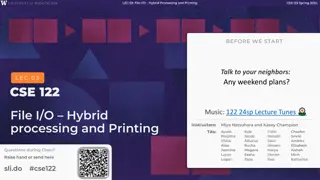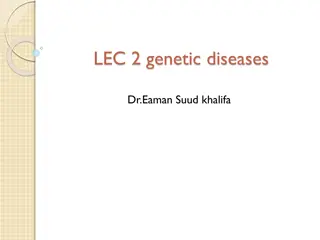
Digital Communications Fundamentals and Applications in CTE Department 2018-2019
Explore the concepts of Digital Communications in the CTE Department's 3rd stage reference materials. Topics covered include Time Division Multiplexing, Noise in Communication Systems, and more. Gain insights into techniques, theories, and applications of digital communications.
Download Presentation

Please find below an Image/Link to download the presentation.
The content on the website is provided AS IS for your information and personal use only. It may not be sold, licensed, or shared on other websites without obtaining consent from the author. If you encounter any issues during the download, it is possible that the publisher has removed the file from their server.
You are allowed to download the files provided on this website for personal or commercial use, subject to the condition that they are used lawfully. All files are the property of their respective owners.
The content on the website is provided AS IS for your information and personal use only. It may not be sold, licensed, or shared on other websites without obtaining consent from the author.
E N D
Presentation Transcript
. : 2018-2019 Digital Communications CTE Department -3rdstage Reference: Digital Communications Fundamentalsand Applications, 2nd Addition, byFernardSklar Dr. Hussam Dheaa Kamel Al-Mustafa University Collage CTE Department 2018-2019
CTE Department -3rdstage Digital Communications 2.2 Time Division Multiplexing (TDM): In PAM, PWM and PPM the pulses is present for short duration and the most time between two pulses is free space, which can be occupied by pulses from other channels. This called TDM. The following figure shows the block diagram of TDM in (a) and the waveforms in (b). If the highest signal frequency is W and its sampling rat ??should be ?? 2?, therefore the time space between two pulses ??=1, thus the time interval ??should contain one sample from each N input channel. That is on frame of ??seconds ?? 2
CTE Department -3rdstage Digital Communications 1 contain total N samples. So that the space between two samples=??= ???, and number of pulses per second is = ?= ? ??? ?? ? 1/??= ???, or the signaling rate ? = ???, and we have ?? 2?, then the signaling rate ? = 2??. The TDM signal should pass through low pass filter with bandwidth Bb of half signaling rate: ??= 1 ? = 1 ???, the transmission bandwidth of TDM ??channel must equal to ?? 2 2 1 ??= ??= 2???, ????? ???? ? ???????? ???? ??= ??????? ???? = 2? 1 ??= 2 ? 2? = ?? The receiver of TDM should operate in perfect synchronization with the transmitter. Therefor marker pulses are inserted to indicate the separation between two frames as shown in the figure: 3
CTE Department -3rdstage Digital Communications Because each frame will increased by one pulse for the purpose of synchronization, the number of channels will reduced to N-1. Example: Twenty four voice signals are sampled uniformly and then time division multiplexed. The highest frequency component for each voice signal is 3.4 kHz.If the signal is pulse amplitude modulated using Nyquist rate sampling, what is the minimum channel bandwidth required. Solution: Here ? = 24, ???? = 3.4???, ?? ? ? ?????????????????????: ??= ?? = 24 3.4??? = 81.6??? 4
CTE Department -3rdstage Digital Communications 2.3 Noise in communication systems: The term noise refers to unwanted electrical signals that are always present in electrical systems. Noise arise from a variety of sources, both man-made and natural. Good engineering design can eliminate of noise or its undesirable effect through filtering, shielding, the choice of modulation, and select optimum receiver site. However there is one natural source of noise, called thermal or Johnson noise, that cannot be eliminated. We can describe thermal noise as a zero- mean Gaussian random process n(t). the value n at any arbitrary time t is statistically characterized by Gaussian probability densityfunction: 2 1 exp [ 1 (?) ] ?(?) = 2 ? ? 2? Where ?2 is the variance of n. The normalized or standardized Gaussian density function of a zero-mean process is obtained by assuming that ? = 1. This normalized pdf is shown in Fig.1. 5
CTE Department -3rdstage Digital Communications ] Figure 1 The fallowing equation represent a sum of DC signal and Gaussian noise random variable: ? = ? +? The pdf p(z) is the expressed as: exp [ 1 ? ?) ] 2( 2 1 ?(?) = ? ? 2? The primary spectral characteristic of thermal noise is that its power spectral density is the same for all frequency (from dc to about 1012 Hz) and it is called white noise. 6
CTE Department -3rdstage Digital Communications ?0 2 ? (?) = ?????/ ???? ? Figure2 2.4 Baseband Demodulation: During a given signaling interval T, a binary baseband system will transmit one of two waveforms, denoted ?1(?) and ?2(?). Then, for any binary channel, the transmitted signal over a symbol interval (0, T) is represented by: 1 ? (?) ?2(?) 0 ? ? 0 ? ? ??? ? ??????1 ??? ? ??????0 ? ? (?) = { The received signal represent by: 7
CTE Department -3rdstage Digital Communications ?(?) = ??(?) ?(?) + ?(?) ? = 1, .,? Where ?(?) is the impulse response of the channel, ?(?) is Additive White Gaussian Noise (AWGN) and represent a convolutional operation. For ideal distortionless channel: ?(?) = ??(?) + ?(?) ? =1,2, 0 ? ? Receiving Filter Threshold Comparison Si(t) r(t) Message AWGN Figure 3 The goal of the receiving filter is to recover a baseband pulse with the best possible signal to noise ratio (SNR), free of intersample interference (ISI). The optimum receiving filter for accomplishing this is called matched filter or correlator. At the output of sampler, is predetection point, yields a sample z(T), sometime called test statistic. ?(?) = ??(?) + ?0(?) ? =1,2 The noise component n0is zero mean Gaussian random variable, and thus z(T) is a Gaussian random variable with a mean of either a1or a2depending on whether a binary one or binary zero was sent. The conditional pdfs ?(? ?1) and ?(? ?2) can be expressed as: 8
CTE Department -3rdstage Digital Communications exp [ 1 ? ?1) ] 2( 2 1 ?(?|? )= 1 ? ? 2? and exp [ 1 ? ?2) ] 2( 2 1 ?(?|? )= 2 ? ? 2? These conditional pdfs are shown in Fig. 4. The rightmost pdf, ?(?|?1), called the likelihood of s1, illustrates the pdf of the random variable z(T), given that symbol s1 was transmitted, and similarly for s2 as shown inFig.4 Figure 4 Since z(T) is a voltage signal that is proportional to the energy of the received symbol, the larger the magnitude of z(T), the more error free will be the decision making process. ?(?)>?1? <?2 9



![Lec [2] Health promotion](/thumb/274962/lec-2-health-promotion-powerpoint-ppt-presentation.jpg)